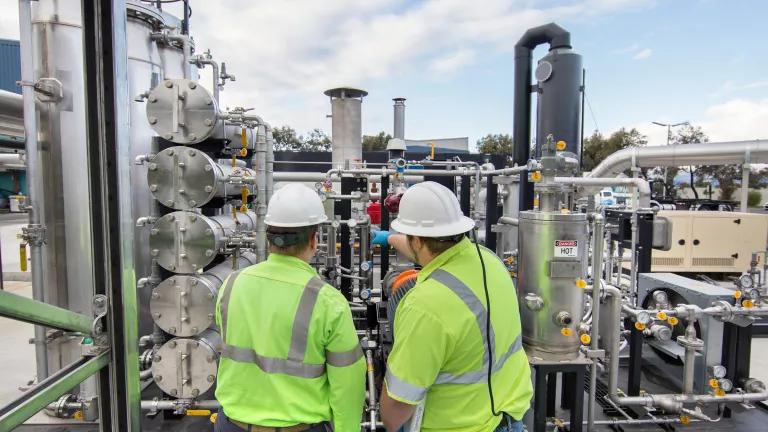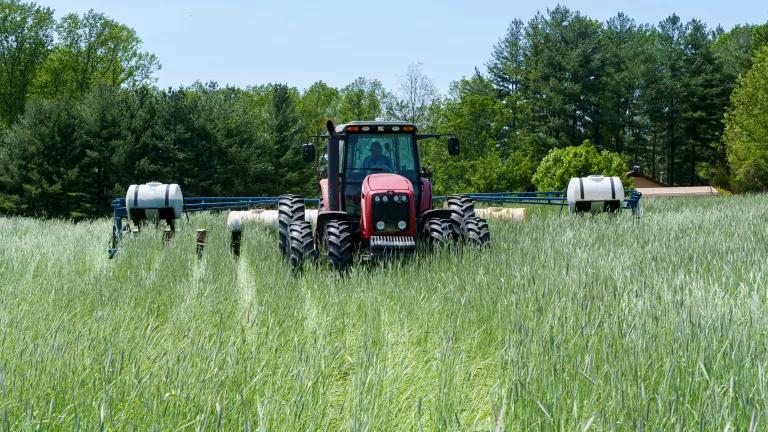Evaluating Anaerobic Digestion for Municipal Organics Recycling
Anaerobic digestion (AD) can be an effective component of a municipal organics recycling system, but it has numerous potential pitfalls.

Two workers inspect pipes at a dry anaerobic digestion (AD) solid waste processing facility which converts food and green organic waste into biogenic compressed natural gas (CNG) and soil amendments in San Francisco, California.
Billy Hustace/Corbis via Getty Images
Anaerobic digestion (AD) can be an effective component of a municipal recycling system, ensuring that organic materials like food scraps are processed for use as soil amendments while also extracting energy as a secondary benefit. However, AD also has numerous potential pitfalls.
Anaerobic digestion (meaning “without oxygen”) is a type of organics recycling in which organic materials such as food waste and grass clippings are subjected to controlled breakdown in an enclosed chamber in the absence of oxygen. Microorganisms that thrive in an anaerobic environment break down the organic material into an energy-rich biogas primarily composed of methane (CH4) and carbon dioxide (CO2), which can be used to generate electricity or heat or to create liquid fuels. Anaerobic digestion also creates solid and liquid products (digestate) that contain nutrients such as nitrogen. In an anaerobic digestion process, the energy embedded in food waste is captured and used to produce energy, rather than released as heat. Generally, the process takes between two to six weeks, not including the time required to compost or cure digestate. An ideal anaerobic digestion system, or responsible AD, will create both digestate that can be used to make soil amendments (“closing the loop” by returning carbon and nutrients to soil) and energy products (a secondary benefit).
The following, modified from NRDC’s report Wasted: How America is Losing up to 40 Percent of its Food from Farm to Fork to Landfill, are best practices to ensure that anaerobic digestion operations are most effective and avoid any additional detriment.
Follow the general principles of the EPA Food Recovery Hierarchy to prioritize waste reduction and prevention. Before implementing AD, ensure that overall reduction and waste prevention initiatives, including surplus food rescue, are in place to reduce the amount of organic waste produced. Organics recycling should be right-sized to account for prevention measures, and municipal outreach to businesses and residents about organics recycling should include waste prevention tips too. (Note that NRDC follows a modified version of the hierarchy, which considers responsible AD and composting as being on the same organics recycling tier.)
Feed the soil. A significant quantity of material entering a digester remains as liquids and solids at the end of the process, and this digestate should be processed through composting or curing to enable its incorporation into soil wherever possible. The primary benefits of recycling are not just diversion from disposal, but the resource savings and pollution avoidance that occur when recovered materials are returned to a production cycle; this applies as well to organics recycling, where primary benefits occur when carbon and nutrients are returned to the soil so they can be “recycled” into new growth. Any energy generation should be managed so as to ensure the primary goal of returning materials to soil can be maximized. Potential benefits to soil from adding compost or appropriately-treated digestate also include increased water and nutrient retention, improved soil productivity and soil health, reduced reliance on fertilizer, and carbon sequestration.
Direct waste materials to their highest and best ecological use. After maximizing waste prevention and redistributing surplus food, the highest and best use for most organic waste materials is to process them for use as soil amendments, where the embedded nutrients and carbons can be returned to an agricultural production cycle. AD may not always be the best technology for processing a particular waste stream, given the potential ecological and economic value of the specific feedstocks, the high cost of implementation, and the destination of the materials produced. The choice of AD versus composting or other options should take into account whether nutrients will be preserved or lost (for instance, if digestate is landfilled after energy extraction, then nutrients are lost), and how to maximize their utility in feeding soils. Many communities are sending (or considering sending) food scraps to wastewater or sewage treatment plant digesters (a process known as co-digestion), either by truck or through wastewater systems (including via liquefier technologies, which are not complete organics recycling systems, despite frequent marketing to the contrary). In that scenario, it is important to consider the fate of the sewage sludge (also known as biosolids) which results from the particular AD process; currently, more than half of all biosolids in the U.S. are either landfilled or incinerated, and biosolids that are land-applied may not be sufficiently treated to address toxics concerns.
Landfilling and incineration are disposal, not recycling, so if a community is sending food scraps to a wastewater treatment plant (WWTP) AD as part of an overall organics recycling program, and those food scraps (incorporated into the biosolids) are landfilled or incinerated, that community is not actually achieving recycling for those materials.
Make AD part of a larger system of organics management. Processes and technologies for particular digesters should be selected to correspond to the types of feedstock (inputs) and projected outputs. For example, yard waste generally does not break down completely in a digester; while some types of dry AD benefit from the addition of landscaping waste as a bulking agent, that type of lignin-rich waste will not fully decompose in the digestion process and will need to be “finished” after the AD process by composting or another method of curing. Wet AD generally cannot process woody waste (or paper, or compostable serviceware) and is best suited for separated food scraps or similar materials. Consequently, composting will nearly always need to be included as part of a responsible organics recycling system, both to break down materials that don’t decompose in the anaerobic process (such as woody waste and compostable plastics) to create a usable soil amendment, as well as to remove pathogens from AD digestate (since, depending on the system, these may not be fully destroyed in the anaerobic digestion process). Many communities have more than one organics recycling system. The size of digesters can be tailored to fit a community’s particular needs, and systems can be combined with each other. Anaerobic digestion may work best for communities prioritizing recycling pre-consumer food waste or other organics which are typically less contaminated and which easily break down in the anaerobic process. Organic waste that contains significant amounts of food-soiled paper, compostable bioplastics, and/or landscaping waste may not break down sufficiently in an anaerobic digestion process and may need to be sent to an aerobic composting system (either after or in lieu of anaerobic digestion). And with any organics recycling system, municipalities can help drive efficiency in the system by purchasing or selling finished compost products.
Select processes and technologies to correspond to the quantities of feedstock. Prioritizing prevention and reduction means ensuring that proposed AD systems are not scaled too large, which can disincentivize reduction efforts. Ensure that the AD can handle loads of varying sizes (or intermittent use) and that any reduction in input does not necessarily mean needing to seek other feedstocks to meet capacity. Scope projected types and quantities of feedstocks out several years to ensure right-sizing of the operation.
Reduce contamination. Ensure source-separated feedstock so as to maximize use of digestible components and reduce reliance on separation technologies and processes. Lower contamination will also help ensure technologies are operating at higher efficiency. “Garbage in, garbage out” applies to actual waste too, not just computer science: if highly contaminated or “mixed waste” feedstock is placed in a digester, highly contaminated digestate will be produced. Using feedstock that has been separated at the source, rather than relying on inefficient and incomplete processes to separate waste at the AD facility, can help ensure that you achieve actual recycling and don’t have to landfill or incinerate all or part of the digestate.
Don’t pollute. Make sure the AD employs the best available controls and procedures to prevent emissions to air and water. Particular concerns include nitrogen to groundwater and air pollutants including carbon dioxide.
The above tips are only some of the factors that should be considered when optimizing a municipal organics recycling system; cost, job creation, and goals related to waste reduction, climate, and sustainability are some others. Finally, as part of a holistic and effective organics recycling program, in addition to balancing industrial AD with industrial composting, promote small-scale composting options (community and/or home composting) to improve your organics recycling system resiliency, create jobs, and involve and benefit communities.




